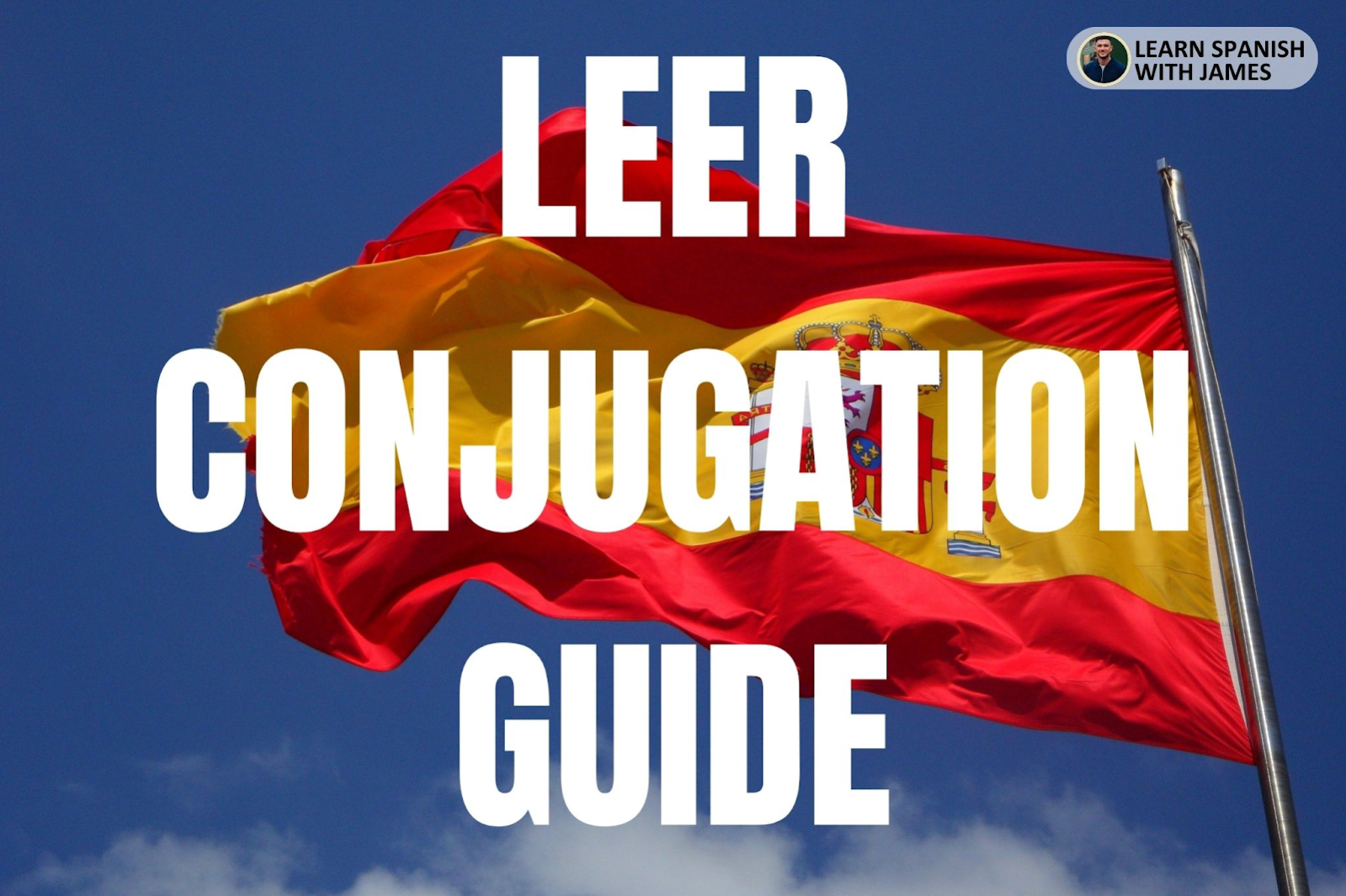Leer Conjugation Chart & Full Tense Guide

“Leer” is a Spanish irregular verb meaning “to read”. It is one of the 100 most common verbs in the Spanish language.
I’m James, from Learn Spanish With James, and the host of the Learn Spanish With James Podcast. In this guide, you’ll learn how to conjugate “leer” in every Spanish tense.
I also provide example sentences with translations, so that you can see how to conjugate “leer” in context.
I want this guide to be your reference point for all “leer” conjugations.
My goal? For you to enhance your ability to communicate fluently in Spanish 🙂
Present Tense
Pronouns Pronombres Conjugation
I yo leo
you tú lees
he,she,it, you(formal) él,ella,usted lee
we nosotros,nosotras leemos
you pl. vosotros, vosotras leéis
they, you pl. (formal) ellos,ellas,ustedes leen
When We Use the Present Tense
The present tense in Spanish is used to describe actions that are currently happening or habitual actions (things you do regularly).
In the case of the verb “leer,” which means “to read,” the present tense indicates ongoing or habitual reading activities.
Take note of the “leer” conjugation chart above, as well as the example sentences below.
Examples of the Spanish Verb “Leer” in the Present Tense
- Yo leo un libro. (I read a book.)
- Tú lees el periódico. (You read the newspaper.)
- Él/Ella lee una revista. (He/She reads a magazine.)
- Nosotros leemos novelas. (We read novels.)
- Vosotros leéis cuentos. (You all read stories.)
- Ellos/Ellas/Ustedes leen poesía. (They read poetry.)
Preterite Tense
Pronouns Pronombres Conjugation
I yo leí
you tú leíste
he, she. it, you (formal) él, ella, usted leyó
we nosotros, nosotras leímos
you (plural) vosotros, vosotras leísteis
they, you (pl. formal) ellos, ellas, ustedes leyeron
When We Use the Preterite Tense
The preterite tense in Spanish is used to describe past actions that occurred at a specific point, and are not ongoing.
Read that sentence again and remember it. The preterite tense described a fixed, completed action.
Top Tip: 🔥 Thе verb ”leer” is irregular in the preterite in the third person singular (él, ella, usted) and third person plural (ellos, ellas, ustedes). You’ll notice the “-i” switch to a “-y”. The pronunciation stays the same though.
Examples of “Leer” in the Preterite Tense
- Yo leí un libro ayer. (I read a book yesterday.)
- Tú leíste el periódico esta mañana. (You read the newspaper this morning.)
- Él/Ella leyó una revista la semana pasada. (He/She read a magazine last week.)
- Nosotros leímos el libro de historia anoche. (We read the history book last night.)
- Vosotros leísteis el cuento en la biblioteca. (You all read the story in the library.)
- Ellos/Ellas leyeron el poema en clase. (They read the poem in class.)
Imperfect Tense
Pronouns Pronombres Conjugation
I yo leía
you tú leías
he, she, it, you (formal) él, ella, usted leía
we nosotros, nosotras leíamos
you (plural) vosotros, vosotras leíais
they, you(pl. formal) ellos, ellas, ustedes leían
When We Use the Imperfect Tense
The imperfect tense in Spanish is used to describe ongoing or habitual actions in the past, as well as to describe background information or past actions with no specific endpoint.
This means it differs from the preterite tense. You can analyze the differences in this article, as well as in this guide to Spanish verb tenses.
When conjugating “leer” in the imperfect tense, we refer to reading activities that were ongoing or habitual in the past.
For example, “I was reading” or “I used to read”. Both of these are examples of the imperfect tense in Spanish.
Top Tip: 🔥 The first person singular and the third person singular conjugate the same way in this tense.
Examples of the Imperfect Tense “Leer” Conjugation
- Yo leía un libro cada noche. (I used to read a book every night.)
- Tú leías el periódico mientras desayunabas. (You used to read the newspaper while having breakfast.)
- Él/Ella leía una revista cuando lo llamé. (He/She was reading a magazine when I called him/her.)
🤓 Note: “llamé” is an example of a “llamar” conjugation in the preterite tense. - Nosotros leíamos cuentos de hadas cuando éramos niños. (We used to read fairy tales when we were children.)
🤓 Note: “éramos is an example of a “ser” conjugation in the imperfect tense. - Vosotros leíais novelas de aventuras durante el verano. (You all used to read adventure novels during the summer.)
- Ellos/Ellas leían poesía en el parque todos los domingos. (They used to read poetry in the park every Sunday.)
Future Tense
Pronouns Pronombres Conjugation
I yo leeré
you tú leerás
he,she,it, you(formal) él,ella,usted leerá
we nosotros,nosotras leeremos
you pl. vosotros, vosotras leeréis
they, you pl. (formal) ellos,ellas,ustedes leerán
When We Use the Future Tense
The future tense in Spanish is used to indicate actions that will occur in the future.
Remember this word “will”. The future tense in Spanish always means “will”.
Each “leer” conjugation in the future tense is very easy to learn. Just learn the appropriate endings and add them to the end of the infinitive form.
Examples of the Future Tense “Leer” Conjugation
- Yo leeré ese libro mañana. (I will read that book tomorrow.)
- Tú leerás la novela el próximo fin de semana. (You will read the novel next weekend.)
- Él/Ella leerá el artículo después de la cena. (He/She will read the article after dinner.)
- Nosotros leeremos el poema en la ceremonia. (We will read the poem at the ceremony.)
- Vosotros leeréis el ensayo para la clase. (You all will read the essay for class.)
- Ellos/Ellas/Ustedes leerán el cuento en voz alta. (They will read the story aloud.)
Conditional Tense
Pronouns Pronombres Conjugation
I yo leería
you tú leerías
he,she,it, you(formal) él,ella,usted leería
we nosotros,nosotras leeríamos
you pl. vosotros, vosotras leeríais
they, you pl. (formal) ellos,ellas,ustedes leerían
When We Use the Conditional Tense
The conditional tense in Spanish is used to express hypothetical actions or events that would occur under certain conditions.
Notice the difference between “will” and “would”? One is definitive, and the other is conditional. Hence the name “the conditional tense”.
Top Tip: 🔥 The conditional tense is a great tense to use with the imperfect subjunctive. Read the example sentences below and you’ll see how to do this in context. Trust me, it’s the quickest way to score big in your speaking exams!
Examples of the Conditional “Leer” Conjugation
- Yo leería más si tuviera tiempo. (I would read more if I had time.)
- Tú leerías el periódico si estuvieras en casa. (You would read the newspaper if you were at home.)
🤓 Note: “estuvieras” is an example of an “estar” conjugation in the imperfect subjunctive form. - Él/Ella leería la novela si le interesara. (He/She would read the novel if he/she were interested.)
- Nosotros leeríamos el libro si lo encontráramos. (We would read the book if we found it.)
🤓 Note: “encontráramos” is an example of an “encontrar” conjugation in the imperfect subjunctive form. - Vosotros leeríais el artículo si estuviera disponible. (You all would read the article if it were available.)
- Ellos/Ellas leerían el poema si les pidieras. (They would read the poem if you asked them to.)
🤓 Note: “pidieras” is an example of an “pedir” conjugation in the imperfect subjunctive form.
Perfect Tense
Pronouns Pronombres Auxiliary verb ‘haber’ Past Participle
I yo he leído
you tú has leído
he,she,it, you(formal) él,ella,usted ha leído
we nosotros,nosotras hemos leído
you pl. vosotros, vosotras habéis leído
they, you pl. (formal) ellos,ellas,ustedes han leído
When We Use the Perfect Tense
The perfect tense in Spanish indicates actions that were completed recently or have been completed.
When we want to conjugate “leer” in the perfect tense, we need the auxiliary verb “haber” and the past participle “leido.”
Look at the “leer” conjugation chart above to see hwo to conjugate “haber” and adopt the past participle from “leer”.
Top Tip: 🔥 Do not confuse the past participle – “leído” – with the present participle ”leyendo”. Remember, “leído” means “read” and “leyendo” means reading. We call and “-ing” the gerund form.
Examples of each Perfect Tense “Leer” Conjugation
- Yo he leído ese libro ya. (I have already read that book.)
- Tú has leído el artículo esta mañana. (You have read the article this morning.)
- Él/Ella ha leído la revista recientemente. (He/She has read the magazine recently.)
- Nosotros hemos leído el periódico hoy. (We have read the newspaper today.)
- Vosotros habéis leído el cuento varias veces. (You all have read the story several times.)
- Ellos/Ellas han leído el poema antes. (They have read the poem before.)
Pluperfect Tense
Pronouns Pronombres Auxiliary verb ‘haber’ Past Participle
I yo había leído
you tú habías leído
he,she,it, you(formal) él,ella,usted había leído
we nosotros,nosotras habíamos leído
you pl. vosotros, vosotras habíais leído
they, you pl. (formal) ellos,ellas,ustedes habían leído
When We Use the Pluperfect Tense
The pluperfect tense in Spanish, also known as the past perfect tense in English, is used to indicate actions that had occurred before another past action or a specified point in the past.
This may sound complex, but it’s very simple. For example, “I had read that book before she recommended it”. The “had” in this sentence is our pluperfect tense.
Again, in order to conjugate “leer” in the pluperfect tense, we need the auxiliary verb “haber” and the past participle “leido.”
Examples of the Pluperfect “Leer” Conjugation
- Yo había leído ese libro antes de la clase. (I had read that book before class.)
- Tú habías leído el artículo antes de la reunión. (You had read the article before the meeting.)
- Él/Ella había leído la novela antes de ver la película. (He/She had read the novel before watching the movie.)
🤓 Note: “ver” means “to see” and “mirar” means to watch. But we use “ver” when we talk about watching a film in Spanish. Here, you can find every “ver” conjugation. - Nosotros habíamos leído el cuento antes de la fiesta. (We had read the story before the party.)
- Vosotros habíais leído el poema antes de la presentación. (You all had read the poem before the presentation.)
- Ellos/Ellas habían leído el ensayo antes de la discusión. (They had read the essay before the discussion.)
Future Perfect Tense
Pronouns Pronombres Auxiliary verb ‘haber’ Past Participle
I yo habré leído
you tú habrás leído
he,she,it, you(formal) él,ella,usted habrá leído
we nosotros,nosotras habremos leído
you pl. vosotros, vosotras habréis leído
they, you pl. (formal) ellos,ellas,ustedes habrán leído
When We Use the Future Perfect Tense
The future perfect tense in Spanish is used to express actions that will have been completed by a certain future time.
You get the idea by now. In order to conjugate “leer” in the future perfect tense, we need the auxiliary verb “haber” and the past participle “leido”.
Check out the verb chart above to see how to conjugate “haber” in the future perfect tense, and the sentences below for context.
Examples of the Future Perfect “Leer” Conjugation
- Yo habré leído ese libro para mañana. (I will have read that book by tomorrow.)
- Tú habrás leído el periódico antes de la cena. (You will have read the newspaper before dinner.)
- Él/Ella habrá leído la revista para la próxima semana. (He/She will have read the magazine by next week.)
- Nosotros habremos leído el artículo para la reunión. (We will have read the article for the meeting.)
- Vosotros habréis leído el cuento para la clase. (You all will have read the story for class.)
- Ellos/Ellas habrán leído el poema antes de la presentación. (They will have read the poem before the presentation.)
Conditional Perfect Tense
Pronouns Pronombres Auxiliary verb ‘haber’ Past Participle
I yo habría leído
you tú habrías leído
he,she,it, you(formal) él,ella,usted habría leído
we nosotros,nosotras habríamos leído
you pl. vosotros, vosotras habríais leído
they, you pl. (formal) ellos,ellas,ustedes habrían leído
When We Use the Conditional Perfect Tense
The conditional perfect tense in Spanish is used to express hypothetical actions that would have been completed by a certain point in the past.
When we want to conjugate this Spanish verb in the conditional tense, once again we need the auxiliary verb “haber” and the past participle “leido.”
Top Tip: 🔥 Check out the example sentences below. This is some seriously high level sentence structure, right here. Learn it! You’ll get top marks in your speaking and writing exams.
Examples of the Conditional Perfect “Leer” Conjugation
- Yo habría leído más si hubiera tenido tiempo. (I would have read more if I had had time.)
🤓 Note: “tenido” is an example of a “tener” conjugation in the past participle. - Tú habrías leído el periódico si hubieras estado en casa. (You would have read the newspaper if you had been at home.)
- Él/Ella habría leído la novela si le hubiera interesado. (He/She would have read the novel if he/she had been interested.)
- Nosotros habríamos leído el libro si lo hubiéramos encontrado. (We would have read the book if we had found it.)
- Vosotros habríais leído el artículo si hubiera estado disponible. (You all would have read the article if it had been available.)
- Ellos/Ellas habrían leído el poema si les hubieras pedido. (They would have read the poem if you had asked them to.)
Present Subjunctive
Pronouns Pronombres Conjugation
I yo lea
you tú leas
he,she,it, you(formal) él,ella,usted lea
we nosotros,nosotras leamos
you pl. vosotros, vosotras leáis
they, you pl. (formal) ellos,ellas,ustedes lean
When We Use the Present Subjunctive
This subjunctive mood in Spanish is used to express desires, doubts, wishes, or uncertain actions.
When conjugating Spanish verbs like ”leer” for this mood, we indicate reading activities that are uncertain or dependent on certain conditions.
Examples of the Present Subjunctive “Leer” Conjugation
- Es importante que yo lea ese libro. (It’s important that I read that book.)
- Yo espero que tú leas ese libro. (I hope that you read that book.)
- Es importante que él/ella lea el artículo. (It’s important that he/she reads the article.)
- Dudo que nosotros leamos la novela. (I doubt that we will read the novel.)
- Quiero que vosotros leáis el cuento. (I want you all to read the story.)
- Esperamos que ellos/ellas lean el poema. (We hope that they read the poem.)
Imperfect Subjunctive
Pronouns Pronombres Conjugation
I yo leyera, leyese
you tú leyeras, leyeses
he,she,it, you(formal) él,ella,usted leyera, leyese
we nosotros,nosotras leyéramos, leyésemos
you pl. vosotros, vosotras leyerais, leyeseis
they, you pl. (formal) ellos,ellas,ustedes leyeran, leyesen
When We Use the Imperfect Subjunctive
The imperfect subjunctive in Spanish is used to express desires, doubts, wishes, or uncertain actions in the past.
If we want to conjugate “leer” in the imperfect subjunctive, we need to learn each conjugation (as above and in the sentences below).
Examples of “Leer” in the Imperfect Subjunctive
- Deseaba que yo leyera el libro. (I wished that I read the book.)
- Yo quería que tú leyeras ese libro. (I wanted you to read that book.)
- Prefería que él/ella leyera el artículo. (I preferred that he/she read the article.)
- Dudábamos que nosotros leyéramos la novela. (We doubted that we would read the novel.)
- Queríamos que vosotros leyerais el cuento. (We wanted you all to read the story.)
- Esperábamos que ellos/ellas leyeran el poema. (We hoped that they would read the poem.)
Affirmative Imperative
Pronouns Pronombres Conjugation
you tú ¡lee!
he,she,it, you(formal) él,ella,usted ¡lea!
we nosotros,nosotras ¡leamos!
you pl. vosotros, vosotras ¡leed!
they, you pl. (formal) ellos,ellas,ustedes ¡lean!
When We Use The Affirmative Imperative
The affirmative imperative in Spanish allows us to give commands or orders in a direct and affirmative manner.
When we use the affirmative imperative form of “leer,” we instruct someone to read or encourage them to engage in reading.
It can also mean “let’s” e.g. “Let’s read a book together.”
Examples of the Affirmative Imperative “Leer” Conjugation
- Lee ese libro ahora mismo (Read that book right now!)
- Leer esta revista. (Read this magazine.)
- Lea el periódico todos los días. (Read the newspaper every day.)
- Leamos el poema juntos. (Let’s read the poem together.)
- Leed este cuento interesante (Read this interesting story!)
- Lean estos artículos para la tarea. (Read these articles for homework.)
Negative Imperative
Pronouns Pronombres Conjugation
you tú ¡no leas!
he,she,it, you(formal) él,ella,usted ¡no lea!
we nosotros,nosotras ¡no leamos!
you pl. vosotros, vosotras ¡no leáis!
they, you pl. (formal) ellos,ellas,ustedes ¡no lean!
When We Use The Negative Imperative
The negative imperative forms of Spanish verbs give commands or orders in a direct and negative manner, instructing someone not to do something.
When using the negative imperative with the verb “leer,” we just need to add “no” before the conjugated form, and adopt the subjunctive endings.
Examples of the Negative Imperative “Leer” Conjugation
- ¡No leas ese libro ahora! (Don’t read that book now!)
- No lea esta revista aburrida. (Don’t read this boring magazine.)
- No leáis el periódico hoy. (Don’t read the newspaper today.)
- No leamos el poema otra vez. (Let’s not read the poem again.)
- ¡No lean esas historias de terror! (Don’t read those horror stories!)
- No lean durante la clase. (Don’t read during class.)
Online Spanish Courses & Grammar Courses
I hope you found this “leer” conjugation guide useful 🙂
For a full list of Beginner, Intermediate and Advanced Courses, check out this full list of online Spanish courses.
I put this list together myself, and it comprises a mixture of courses that offer Spanish grammar practice for all levels, conversational practice, listening and writing exercises in Spanish, free Spanish courses, and a whole lot more.
The fastest way to learn Spanish is to test a mixture of Spanish resources and choose the course that coincides most with your learning style.
In addition to online Spanish courses, on this site you will find a wide range of Spanish podcasts, Spanish apps, Spanish YouTube channels, and both online and physical Spanish language schools.

About James – Or Should that be Santiago?
My name is James. I am a Brit with a love for the Spanish language. I have lived in Spain, Argentina, and Costa Rica, and I have been teaching Spanish for over a decade. This site will show you how to master the elements of Spanish grammar that often dishearten learners. I hope you enjoy the site and find it useful.
If you are interested in taking your Spanish to the next level, check out the Courses section for a full list of the Spanish courses I suggest. All reviews are based on my personal opinions.







